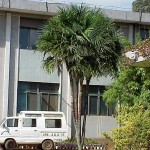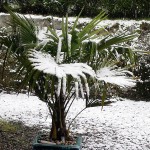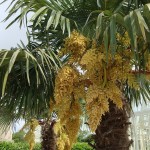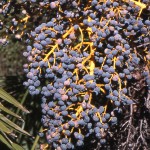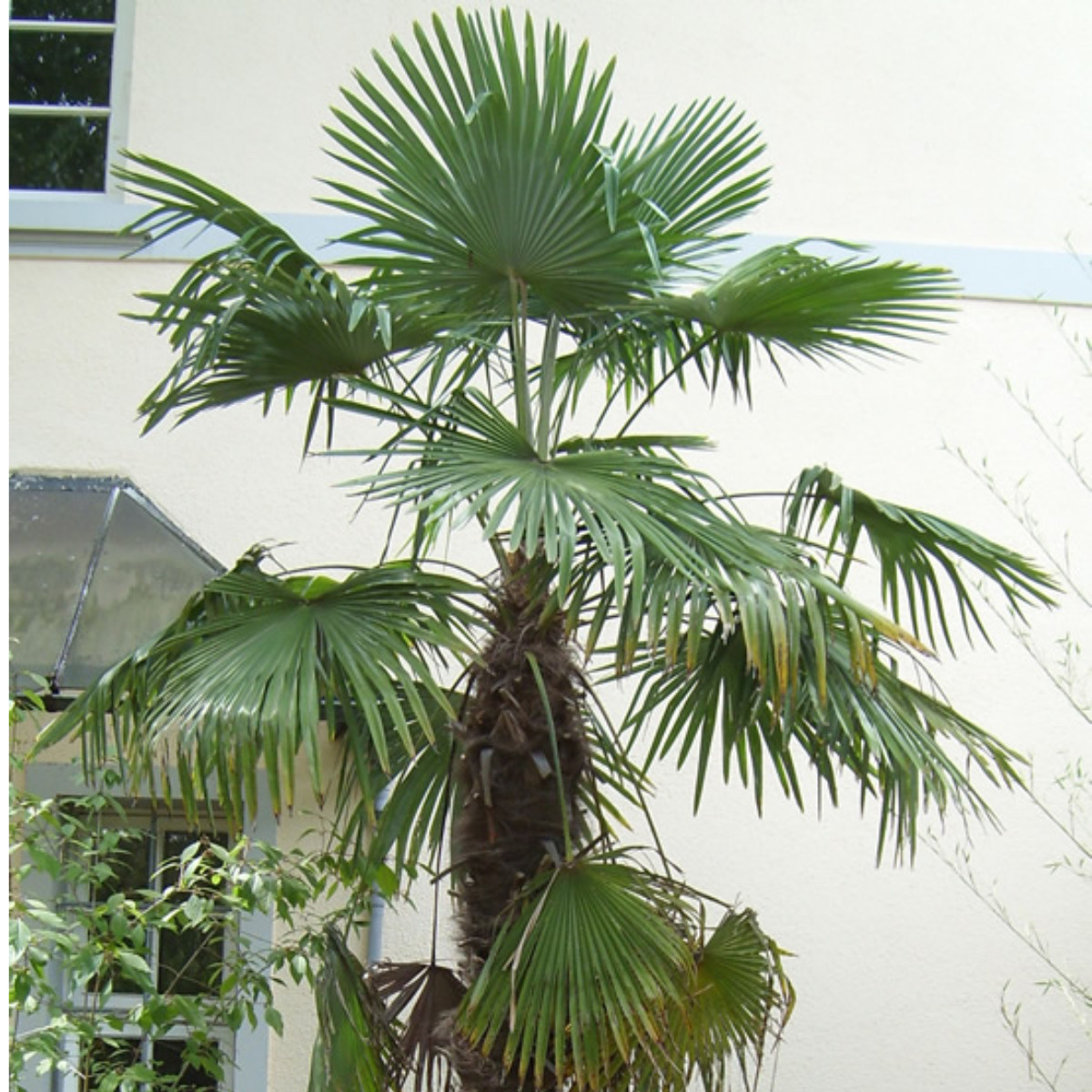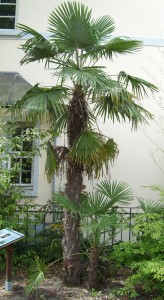Family: Arecaceae
Synonymous: Chamaerops excelsa
Chamaerops fortunei
Trachycarpus caespitosus
Trachycarpus wagnerianus
Distribution and habitat: Trachycarpus fortune is a palm native to central China, south to northern Burma and northern India, growing at altitudes of 100 to 2400m (3287874 feet). It is one of the hardiest palms growing in the mountains of southern China. This brings it into a climate not only with cold winters, but also cool, moist summers.
Today, being widely cultivated throughout China, Japan and SE Asia for the fibres within the leaf stalk and it is rarely found in forests.
Trachycarpus fortunei is cultivated as a trunking palm in gardens and parks throughout the world in warm temperate and subtropical climates. Its tolerance of cool summers and cold winters makes it highly valued by palm enthusiasts, landscape designers and gardeners. It can be grown successfully in such cool and damp but relatively winter-mild locales as Scotland and British Columbia Canada, as well as in warm temperate climates in parts of the United States, Europe, New Zealand and Asia. It does not grow well in very hot climates.
Description: Trachycarpus fortunei has a slender stem that bears fan shaped leaves with finely toothed stalks a metre (3 feet) or so long. In wild Trachycarpus fortunei grows about 12m (40 feet) tall, but growth indoors is slow and plants are unlikely to reach a height of more than 2.5m (8 feet) in the home. When young, the leaves are pleated and they are covered with fine short grey or light brown hair. As the leaves ages, this woody covering disappears and the pleats divide almost to the base into many stout but pliant segments, each up to 30cm (12 inch) long and 2-3cm (1 inch) wide. Individual segments are sometimes pleated into two or three fronds. The mature leaves are up to 60cm (24 inch) wide and dark green above, bluish green below. The main stem which does not normally branch, becomes covered with a coarse brown fibre.
Eventually the leaves turn from green to yellow to brown, but they do not fall off. They should be gently pulled away or cut off when they become unsightly. The tips of the leaf segments, in particular, become discoloured with age and are liable to split along about 2cm (0.8 inch) or more of their length. This is natural and is not necessary a sign of illness. An affected tip can be cut off without detriment to the rest of the leaf.
The flowers and fruits which are produced by mature Trachycarpus fortunei palms are not normally found on indoor specimens. Male and female flowers are borne on separate plants (dioecious). The flowers are densely arranged on 0.5-1m (2-3 feet) long branched stalks called an inflorescence. The Trachycarpus fortunei palm's bright yellow inflorescence erupts from a packet-like bud in late winter and early spring and is held within the crown. On female plants the flowers are followed in late summer by round or oblong blue fruits that are about 1.5cm (0.5 inch) in diameter.
Houseplant care: Trachycarpus fortunei is the only species from its genus grown as an indoor plant.
Stand these palms when are not kept outdoor in the milder months in gentle rain or wash them carefully under cold shower in order to free them of the accumulation of dirt and dust that collects on the leaves.
Light: Throughout the year, Trachycarpus fortunei palms need bright light with three or four hours a day of direct sunlight. New growth will be limited if palms receive insufficient light.
Temperature: These plants not only grow well in normally warm room temperatures, but are also completely unharmed by temperatures down to 7C (45F). If possible stand the Trachycarpus fortunei palms outdoors in a sheltered but sunny position from late spring to about mid-autumn. This will promote new growth and encourage the development of stiff, healthy leaves.
Watering: Water actively growing palms moderately, giving enough water to make the potting mixture thoroughly moist, but allowing the top centimetre (0.4 inch) or so of the potting mixture to dry out before watering again. In a normally warm room temperature Trachycarpus fortunei will not have a regular rest period, but its growth will slow down or even stop whenever the temperature drops 12C (54F). At such times, it is best to water only once a month and sparingly - just enough to make the potting mixture barely moist throughout.
Feeding: Apply standard liquid fertiliser to actively growing plants about once every two weeks.
Potting and repotting: Use a soil based potting mixture. Move small Trachycarpus fortunei palms into pots one or, at the most, two sizes larger every second or third spring until the maximum convenient size is reached (likely to be 25-30cm - 10-12 inch). Thereafter, it should suffice to top-dress these palms with fresh potting mixture.
Gardening: Trachycarpus fortunei palm prefers cooler, temperate areas and although it will grow in the sub-tropics, but it will struggle in the tropics. This is a hardy palm and can withstand subfreezing temperatures. In its native habitat, this tough palm is sometimes subjected to a cover of snow and ice. This palm should be planted in sheltered sites when grown in hardiness zone 7. Young plants are less hardy and can be damaged by only 8C (17F). Very young plants should be given some protection during their first winter or two outdoors.
Location: Sunny sheltered position, especially from the cold drying winds of the north and east in temperate zones or partial shade in sub-tropical zones are best for Trachycarpus fortunei palms.
This palm is moderately salt tolerant and can be planted behind the first line dunes or against a structure that will shield it from direct exposure to sea breezes. Protection from harsh winds will minimize leaf tearing and will allow this palm look its best. Individual leaves live for about three years if they are not damaged by wind.
Soil: Trachycarpus fortunei does best in well drained soils with above average fertility but it will survive in almost anything except perpetually soggy conditions.
These palms usually have deep penetrating root systems and generally establish best when planted out at a young stage. In areas at the limit of their cold tolerance, therefore, it is prudent to grow the plants in containers for some years, giving them winter protection and only planting them into their permanent positions when sheer size dictates. Plant them out into their permanent positions in late spring or early summer, after the last expected frosts.
These palms can also be transplanted even when very large. Although the thick fleshy roots are easily damaged and / or desiccated, new roots are generally freely produced.
Irrigation: Plants should be watered faithfully. Water the base of palms thoroughly but do not keep wet. Form a small basin around palms to hold irrigation water longer. Mulches help keep shallow palm roots from drying out quickly. Trachycarpus fortunei has moderate drought tolerance.
Fertilising: Fertilize the palm regularly with granular fertilizer intended for palms and follow the label rates and directions.
Propagation: Trachycarpus fortunei are propagated by fresh seed sown in early spring. Seed takes up to a year to germinate, however and the seedling are also slow growing - they may take several years to assume palm like characteristics. The best way to acquire Trachycarpus fortunei palms, therefore, is to purchase the young plants from nurseries or garden centres.
Problem:
Scales and palm aphids are pests of Trachycarpus fortunei.
Treatment: Inspect the palm regularly for insects and use a suitable spray insecticide when necessary.
Trachycarpus fortunei may be infected by root rot, moderately susceptible to lethal yellowing disease and leaf spots caused by a number of fungal pathogens.
Treatment: Avoid over-watering the palm, as this leads to root rot and decay. There is to date no cure for lethal yellowing. Sanitation and water management are critical for leaf spot disease management. Avoid overhead irrigation. These fungal infections are difficult to treat and an accurate diagnosis is essential for proper treatment.
Note: The names Chamaerops excelsus and Trachycarpus excelsus have occasionally been misapplied to Trachycarpus fortunei; this is correctly a synonym of Rhapis excelsa, with the confusion arising due to a misunderstanding of Japanese vernacular names.
Usage and display: Trachycarpus fortunei palm makes a great accent which fits well into small areas like courtyards and entries. It is a tough plant and survives in hot urban landscapes and even thrives there if watered and fed. It is a perfect palm for containers. It is very attractive planted in groves and groupings especially when plants of different heights are staggered in irregular patterns (plant the tallest palms in center of the groups and shorter ones at the edges). These palms can be used successfully lining an entry walk to a large building. This adds a formal elegance to any structure, especially one with glass faade. Also, Mass plantings of Trachycarpus fortunei palms around a patio or sitting area will create an luxuriate atmosphere.
As indoor plant Trachycarpus fortunei palm makes a great plant to any home or office. It will fit into narrow spaces and bring a sense of tropics to any place. Because of its compact foliage and slow growth rate it will make a nice potted plant for a patio, deck or pool.
SUMMARY:
CHARACTERISTICS:
Foliage green
Shape bushy
PROPER CARE:
Watering in rest period sparingly
Watering in active growth period moderately
Light bright
Temperature in rest period min 7C max 24C (45-75F)
Temperature in active growth period min 16C max 24C (61-75F)
Humidity low
Outdoors height: 12m (40 feet)
Outdoor spread: 3m (10 feet)
Indoor Height: 2.5m (8 feet)
Hardiness zone: 8a-11

